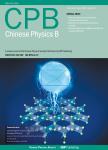Near equilibrium dynamics and one-dimensional spatial–temporal structures of polar active liquid crystals
Near equilibrium dynamics and one-dimensional spatial–temporal structures of polar active liquid crystals作者机构:School of Mathematical Sciences Nankai University Department of Mathematics University of North Carolina at Chapel Hill Department of Mathematics Interdisciplinary Mathematics Institute and NanoCenter at USC University of South Carolina Beijing Computational Science Research Center
出 版 物:《Chinese Physics B》 (中国物理B(英文版))
年 卷 期:2014年第23卷第11期
页 面:75-100页
核心收录:
学科分类:08[工学] 080101[工学-一般力学与力学基础] 0801[工学-力学(可授工学、理学学位)]
基 金:supported by the National Natural Science Foundation of China(Grant Nos.DMS-1200487,DMR-1122483,and NIH 2R01GM078994-05A1) the Air Force Office of Scientific Research(AFOSR)(Grant No.FA9550-12-1-0178) the Army Research Office(Grant Nos.ARO-12-60317-MS and SC EPSCoR GEAR(CI and CRP))
主 题:active liquid crystals active particles spatial-temporal structures spontaneous flows
摘 要:We systematically explore near equilibrium, flow-driven, and flow-activity coupled dynamics of polar active liquid crystals using a continuum model. Firstly, we re-derive the hydrodynamic model to ensure the thermodynamic laws are obeyed and elastic stresses and forces are consistently accounted. We then carry out a linear stability analysis about constant steady states to study near equilibrium dynamics around the steady states, revealing long-wave instability inherent in this model system and how active parameters in the model affect the instability. We then study model predictions for one- dimensional (1D) spatial-temporal structures of active liquid crystals in a channel subject to physical boundary conditions. We discuss the model prediction in two selected regimes, one is the viscous stress dominated regime, also known as the flow-driven regime, while the other is the full regime, in which all active mechanisms are included. In the viscous stress dominated regime, the polarity vector is driven by the prescribed flow field. Dynamics depend sensitively on the physical boundary condition and the type of the driven flow field. Bulk-dominated temporal periodic states and spatially homogeneous states are possible under weak anchoring conditions while spatially inhomogeneous states exist under strong anchoring conditions. In the full model, flow-orientation interaction generates a host of planar as well as out-of-plane spatial-temporal structures related to the spontaneous flows due to the molecular self-propelled motion. These results provide contact with the recent literature on active nematic suspensions. In addition, symmetry breaking pattems emerge as the additional active viscous stress due to the polarity vector is included in the force balance. The inertia effect is found to limit the long-time survival of spatial structures to those with small wave numbers, i.e., an asymptotic coarsening to long wave structures. A rich set of mechanisms for generating and li



